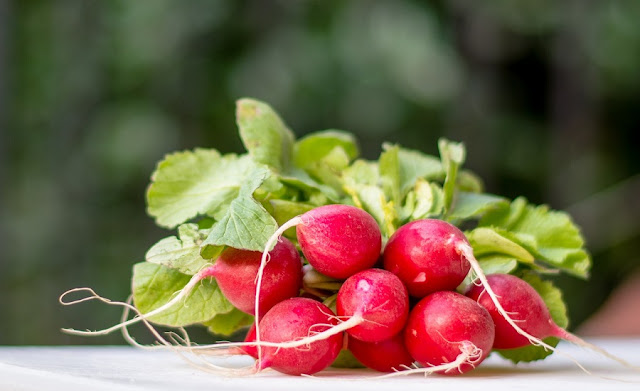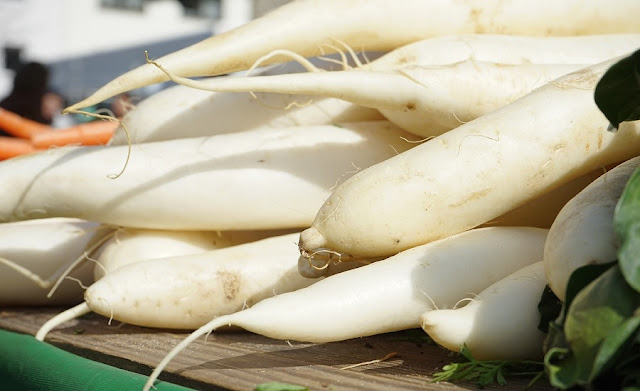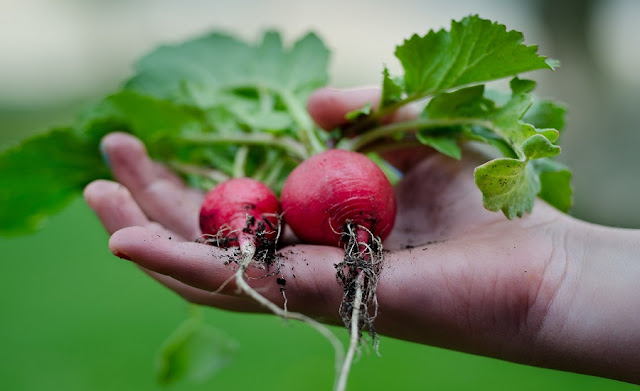The Health Benefits of Eating Radishes
The Health Benefits of Eating Radishes
{getToc} $title={Table of Contents}
The Health Benefits of Eating Radishes
Radish is a nutritional
powerhouse, filled with antioxidants, vitamins, and minerals. It has been
linked to improved health in a variety of ways. Here are some of its health
benefits: It can help prevent cancer, help reverse heart disease, and assist in
weight loss.
radishes can also improve
your mental health. A recent study found that people who eat radishes are less
likely to experience anxiety and depression. The study's authors believe that
the high levels of antioxidants in radishes may be responsible for this effect.
Radishes can also help improve your memory.
Radishes are also a good
source of fiber. Fiber is important for gut health and can help you feel fuller
longer. It can be powerful for weight loss or maintenance. Radishes are low in
energy and high in water, each of which can aid in weight loss.
Related Post: Cauliflower health benefits and side effects (2023)
Benefits of Eating Radish at Night
The health benefits of
eating radish at night include improved digestion due to the high amount of
fiber present in radish. Radishes have been shown to help keep blood pressure
levels stable by reducing sodium levels through the urine.
japanese radish benefits
Japanese Radish is a root
vegetable that is related to the Turnip, Rutabaga and Swede. It is a winter
crop that is planted in the late summer or fall and harvested in the winter or
early spring. Japanese Radish is an excellent source of Vitamin C, Potassium,
Folic Acid and dietary fiber.
Related Post: dates fruit origin. The Benefits of dates fruit. dates inspanish fruit?
Benefits of radish for skin
Radish is a root vegetable
with many benefits for skin. It is a good source of Vitamin C, which is
important for the formation of collagen. Collagen is a protein that allows
maintain the pores and skin searching younger and healthy. Radish is also a
good source of other antioxidants, including Vitamin A, Vitamin E, and
anthocyanins. These antioxidants help protect the pores and skin from damage
caused by free radicals. Radish is effective in treating various skin problems
such as acne, eczema, and psoriasis. It helps to clear the skin and makes it
healthy and radiant. Radish juice is also beneficial in removing dark circles
from under the eyes.
Radish side effects
Radish side effects are
generally mild and short-lived, but can include some unusual symptoms. Here are
a few tips for avoiding potential side effects:
1. Be aware of any possible health problems that may be associated with radish consumption.
2. Avoid eating radishes if you are pregnant, breastfeeding, or have a medical condition that could be affected by radish consumption.
3. If you experience any unusual or unwanted side effects from eating radishes, please consult your
White radish health benefits
White radish health benefits
are numerous. This edible root vegetable is a source of many essential
nutrients required for good health. They also are an amazing supply of diet C
and potassium. The white radish is a root vegetable that is related to the
turnip, cabbage, and Brussels sprouts families. Its scientific name is Raphanus
sativus. It is sometimes called the Japanese radish, German radish, or winter
radish. The white radish is a cool-season crop that is grown in many parts of
the world.
White radish benefits for liver
Radishes are a natural
detoxifier and can help cleanse the liver of toxins. They also promote healthy
digestion and can help prevent constipation. Just a few radishes per day can
make a big difference in your liver health.
Related Post: Himalayan pink salt benefits and side effects
White radish benefits for weight loss
Radishes are low in calories
but high in fiber, which makes them ideal for weight loss. They also contain
compounds that help boost metabolism and burn fat. Adding a few radishes to
your diet can help you reach your weight loss goals.
Radish benefits for lungs
Radishes are rich in
antioxidants, which can help protect the lungs from damage. They also help
improve circulation and can reduce inflammation. Just a few radishes per day
can help keep your lungs healthy and functioning properly.
How many radishes per day should i eat?
There is no one answer to
this question as the amount of radishes you should eat per day will vary
depending on your individual dietary needs and goals. However, in general, it
is recommended that you eat between 2 and 5 servings of radishes each day.
Radishes are a low-calorie vegetable that are high in fiber, vitamin C, and
potassium. They are a good source of antioxidants and can help boost your
immune system. Additionally, radishes may help improve digestion and reduce
inflammation. So, how many radishes should be eaten in accordance with the day?It
really depends on you! However, aim to include at least 2-5 servings of
radishes in your daily diet for best results.
Related Post: Health benefits of coconut flour. 15 Best coconut floursubstitute.
The Complete Guide to Sweet Radish
The name of the restaurant
is derived from a combination of the words “radish” and “sweet”. The founders
wanted to create a place where people could enjoy their favorite foods without
worry about calories, fat, or sugar.
There are many restaurants
that provide healthy food choices for those who want to eat healthier and live
healthier lives. However, Sweet Radish is different in the sense that they take
this idea one step further by making their dishes as low-calorie as possible
and providing menus with nutritional information for customers to easily see
what they are eating.
Sweet Radish has a variety
of menu items that range from salads to wraps to pasta dishes. They have many
options for those who have various dietary needs such as gluten-free,
vegetarian, vegan, and paleo diets.
Sweet Radish also offers
catering services so you can order food in bulk or just pick up enough for your
family at the time.
How to Cook Radishes?
They are a great addition to
any meal, but it can be hard to know how to cook them. This article will show
you how to cook radishes so that they taste delicious and look amazing on your
plate.
The first thing that you
need to do is wash the radishes in cold water until they are clean. You will
then want to peel off the outer layer of the radish with a knife or peeler. You
can then cut them into slices, quarters, or wedges depending on what you prefer
for your dish. The next step is cooking them for two minutes in boiling water
before putting them into an ice bath for about five minutes, this helps stop
the cooking process and keep their vibrant color.
You will want to remove the
pieces from the ice bath and dry them off before adding salt and pepper or
other spices as desired before serving.
Types of radish
Radishes are a type of root
vegetable that come in many different varieties and colors. They are normally
eaten raw, however also can be cooked.The most popular variety of radish is the
red radish. It has a long, thin root with a bright red skin. It is often used
as a garnish for dishes or salads and can be eaten raw or cooked.
Radishes come in many
different shapes, sizes and colors including white, purple, green and black.
They vary in size from small to large with the most common size being about 2
inches long and 1 inch wide.
Daikon radishes
Daikon radishes are a
versatile vegetable enjoyed in many cultures for their slightly sweet, sharp
flavor and crisp texture. In the United States, these winter-hardy white
radishes are often used in salads or as a garnish, but their mild taste and
satisfying crunch also lend themselves well to roasting, steaming, pickling,
and grilling. Daikon radishes are low in calories and a good source of vitamins
C and B6, calcium, and potassium. The large taproots may be as long as two
feet, but daikons are also available in smaller sizes.
Related Post: Health Benefits of seaweed. Seaweed in Spanish. Seaweedchips.
Wild radish
Wild radish is a versatile
root vegetable that can be eaten raw, cooked, or added to soups and stews. It
is a healthy vegetable that is low in calories and has a good amount of
vitamins and minerals.
Wild radish is also known as
Raphanus sativus, and is a member of the Brassica family. This family also
includes other vegetables such as cabbage, broccoli, and kale. The wild radish
is native to Europe, Asia, and Africa. It was introduced to North America in
the early 1600s by European settlers.
Spicy radish
A
spicy radish can add a little zip to your meal. It is a member of the cabbage
family and has a sweet and sour flavor. It is a superb supply of Vitamin C and
folic acid. Some people like to use it in salads or as part of a stir fry.
Radishes and Pregnancy
While pregnant, it is
important to eat a variety of healthy foods in order to give your baby the best
possible start in life. One important group of food items to include in your
diet are vegetables, and particularly the red ones. One vegetable that is
especially beneficial for pregnant women is the radish. Radishes are a good
source of vitamin C, which is important for the healthy development of your
baby's bones, teeth, and gums. They are also a good source of folate, which
helps to prevent birth defects. In addition to being nutritious, radishes are
also low in calories and fat, and they are a good source of dietary fiber.
Eating radishes can help you to maintain a healthy weight during pregnancy, and
they can also help to prevent constipation.
Watermelon Radish
What is a watermelon radish?
This curiously-named vegetable is related to the turnip and is a type of daikon
radish. Watermelon radishes get their name because their exterior looks similar
to that of a watermelon - green with red striations. They are milder in flavor
than other types of daikon radishes.
Related Post: Benefits of extra virgin olive oil
Radish in Spanish
Radish in Spanish is a
nutrient-rich root vegetable that is often used in salads, soups, and
stir-fries. While the English word "radish" comes from the Latin word
"radix," which means "root," the Spanish word for radish is
actually "rábano." Rábano is a versatile vegetable that can be eaten
raw or cooked, and it is often used in Spanish cuisine to add flavor and
nutrients to dishes. In this article, we'll explore the history and nutritional
benefits of rábano, as well as some popular recipes that use this delicious
vegetable.
Radish seeds
Radish seeds can be planted
in the early spring, and they mature rapidly. Radish plants are globular,
typically two to four inches in diameter, with a short stem. The leaves are
suitable for eating and may be eaten uncooked or cooked.
Can you eat radish greens?
Can you eat radish greens? This
is a question that many people have. The answer is yes, you can eat radish
greens. In fact, they are a very healthy food to eat.
Let's talk about radish
greens. Radish greens are the leafy green tops of a radish plant. They are
edible, and they are packed with nutrients. Many people are surprised to learn
that they can eat radish greens. Radish greens
are an amazing supply of nutrients A, C, and K. They also are an amazing
supply of minerals, consisting of potassium, magnesium, and iron.Radish greens
are a low-calorie food, and they are a good source of dietary fiber. Radish
greens can be used in salads, stir-fries, or soups.
Can you eat radish leaves?
Can you eat radish leaves?
This is a question that many people have asked, and the answer is yes – you can
eat radish leaves. Radish leaves are a healthy addition to your diet, and they
are packed with nutrients that your body needs. In this article, we will
discuss the benefits of eating radish leaves, and we will give you some recipe
ideas that will help you enjoy this healthy vegetable.
Conclusion
The health benefits of
eating radishes is a key part of Japanese cuisine. The Japanese radish is a
root vegetable that can be eaten raw, cooked or pickled and comes in many
colors. It is a common ingredient in many Asian recipes. The health benefits of
eating radish at night may surprise you since radish is normally a vegetable
that is included in many meals that are served during the day.
Cauliflower health benefits and side effects (2023)
Health Benefits of seaweed. Seaweed in Spanish. Seaweed chips.
Dates Are Fruit! Why Not Use Dates For Weight Loss?
Health benefits of coconut flour. 15 Best coconut flour substitute.
What is apple cider vinegar? Benefits of Apple CiderVinegar.
How to make black lips pink in natural way
What are the best baby foods to help boost your little one's brain development?
Benefits of extra virgin olive oil
5 Foods You Should Be Introducing to Your Babies Diet
How to Make Baby Foods - Liquid and Oil Based
15 Most Notable Baby Food Dishes 2023





